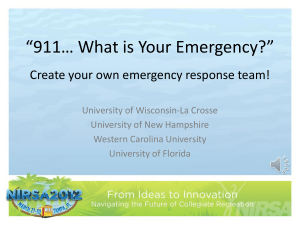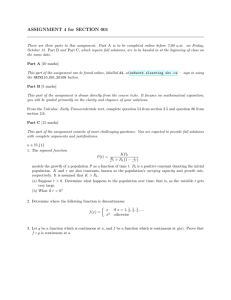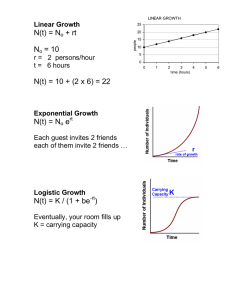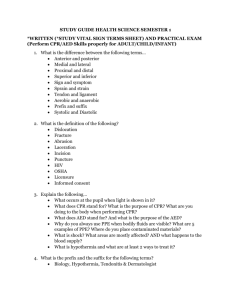Kim Clark, Director, Campus Recreation University of Houston
advertisement
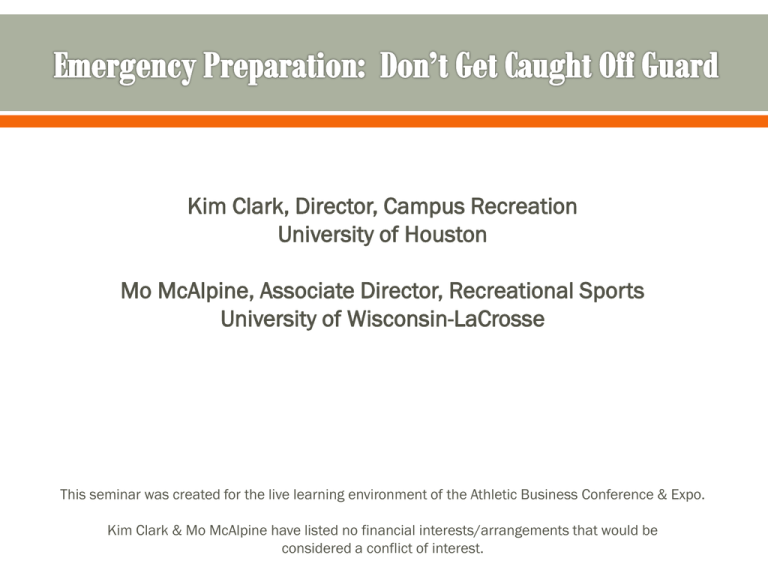
Kim Clark, Director, Campus Recreation University of Houston Mo McAlpine, Associate Director, Recreational Sports University of Wisconsin-LaCrosse This seminar was created for the live learning environment of the Athletic Business Conference & Expo. Kim Clark & Mo McAlpine have listed no financial interests/arrangements that would be considered a conflict of interest. Upon completion of this seminar, you will be able to: o Identify components to incorporate into an Emergency Action plan to prepare students to respond to emergency situations with confidence. o Develop and implement an emergency response team and red shirt reviews to train and prepare your staff to respond to emergencies. o Understand the importance of the debrief process following an incident. Identify Risks Measure/Assess Plan (strategies) Implement Debrief/Evaluate/ Revise FEMA 1979 Identify Risks o Campus o Programs o Facilities o Culture & Climate Assess/Measure Culture & Climate Job Descriptions Certifications & Trainings Meetings/In-services Policies & Protocols EAP Documentation Collaboration Medical o Life-Threatening • Drowning • Severe Bleeding • Heart Attack • Shock • Head, Neck, & Back • Heat Stroke • Stroke • Epileptic, Diabetic & other attacks o Non Life-Threatening • Cuts & Bruises • Sprains & Strains • Dislocations Fire Prevention o Extinguishers o Egress Routes o Signage o Laundry Lint Traps o Chemical Storage o Area Occupancies o Chemicals & Cleaning Solutions Weather o Heavy Rain, Winds, o o o o o Flash Flooding Lightning Hurricanes Tornadoes Earthquake Heat Procedures Shelter in place Weapons Bomb Theft Suspicious Packages/Items Radiation Chemical or Biological Threats Forms & Checklists o Release & Indemnity/Health History Forms o Photo/Video Releases o Safety Checklists • Opening/Closing • Facility Inspection • Equipment Inventory & Inspections • Maintenance Logs • Pool Chemistry Logs • AED Inspection & Maintenance Activating EAP o Implementing appropriate response strategy Communication o Walkie Talkies o Calling 911 Completing Documentation Debrief o Evaluate Response o Review Documentation o Critical Stress Debrief Follow Up o Staff o Participants o Restock Supplies o Inspect/Clean Facility/Equipment Re-open Facility Planning for Recovery begins in the Preparedness Phase!! Iterative Process Dynamic Document Collaborate/Utilize Resources o Bullet Points o Campus Police o Flow Charts o Risk Mgmt./Safety o Diagrams Consistency Across Program Areas Office/Emergency Mgmt. o Counseling & Psychological Services o American Red Cross January 27, 2010 9:24PM 20 year old female Group X Class 21:24:13 - call received by 911 21:25:11 - call dispatched to station 21:26:12 - University Police informed 21:26:20 - call to Mo 21:26:21 - paramedics in route 21:26:46 - face is blue 21:28:40 - AED in use 21:29:00 - University Police arrive 21:30:50 - paramedics on scene 21:31:09 - code in progress 21:49:30 - ambulance departs to hospital 21:57:42 - ambulance arrives at hospital Realistic verbiage on 911 phone calls Building Manager cell phones CPR masks for entire facility and employees Red Cross reference cards Semester CPR & AED reviews with staff Bystander awareness Intentional initiation of emergency response team (ERT) Advisor o Associate Director Chair o Student staff member(s) Representatives o 1 from each position area Other potentials o Police; medical staff; risk management/safety; counseling As a preparatory unit of the Recreational Sports student staff, the Emergency Response Team (ERT) will ensure the readiness of the Recreational Sports Department for any potential emergency, review emergency action plans, and strive for efficiency in upholding accident, incident, and injury protocol. What are your current procedures? o Emergency action plans o Forms & checklists o Documentation - reports o Equipment and supplies o Common practices o Certifications and training of staff o Institutional coordination Purpose: to create a non-intimidating environment with real life situations for staff members to practice and become comfortable implementing EAP’s Resources o Your institution o Other institutions o Conferences o NIRSA Habitat o Certifying agencies & professionals Logistics o Develop scenarios • Currently medical based o Create checklists • Based on EAP & appropriate progression of care • Scene • Front Desk o Train ERT members o Schedule RSR o Plan coverage Red Level o Life-threatening o 911 and University Police o Factors beyond training level o May include first aid treatment o May include progression to shock Green Level o Non-life-threatening o Within training level o May include some first aid treatment o Does not include 911, University Police, or shock Implementation o As realistic as possible Debriefing o Review entire scenario with staff on duty Paperwork o Injury report o Incident report ERT website o www.uwlax.edu/recsports /ert.htm Video Video of mock red shirt review: www.uwlax.edu/recsports/ert.htm Improved responses in daily implementation of emergency situations Increased comfort and level of care Positive comments from University Police Survey results Fall (prior to academic year) o Emergency procedures and action plans o Mini red shirt reviews o Large group debriefings o Facility tours o Introduction to emergency equipment and locations Spring (first week of semester) o Updates on emergency procedures and action plans o Hands on CPR and AED review o First aid presentations by student athletic trainers Certifications o CPR, AED, and first aid (minimum) Weekly Staff Meetings o ERT updates from committee members o Debriefings regarding recent incidents Situational Debriefings o Review with staff involved immediately following situation Identify Risks Measure/Assess Plan (strategies) Implement Debrief/Evaluate/ Revise FEMA 1979 Upon completion of this seminar, you will be able to: o Identify components to incorporate into an Emergency Action plan to prepare students to respond to emergency situations with confidence. o Develop and implement an emergency response team and red shirt reviews to train and prepare your staff to respond to emergencies. o Understand the importance of the debrief process following an incident. U.S. Department of Education. Action Guide for Emergency Management for Institutions of Higher Education. (Revised June 2010). Available at http://rems.ed.gov/docs/REMS_ActionGuide.pdf U.S. Department of Education. Practical Information on Crisis Planning: A Guide for Schools and Communities. (Revised January 2007). Available at http://www2.ed.gov/admins/lead/safety/emergencyplan/crisisplanning.pdf U.S. Department of Homeland Security, Federal Emergency Management Agency. Building a Disaster-Resistant University. (2003). Available at http://www.fema.gov/hazard-mitigation-assistance/building-disasterresistant-university Thank You Video Kim Clark, Director University of Houston kdclark@central.uh.edu www.uh.edu/recreation Mo McAlpine, Associate Director UW-La Crosse mmcalpine@uwlax.edu www.uwlax.edu/recsports www.uwlax.edu/recsports/ert.htm
